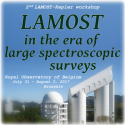Speaker
Dr
Antonio Frasca
(INAF - Osservatorio Astrofisico di Catania)
Description
We present the results of the analysis of LAMOST spectra in the Kepler field with the ROTFIT pipeline. The application of our code to these spectra has allowed us to perform an MK spectral classification and to derive the atmospheric stellar parameters (Teff, logg and [Fe/H]). Moreover, we have also measured the radial velocity of the targets and provide an estimate of the projected rotational velocity for the very rapid rotators in the analyzed sample. The use of low-activity real-star spectra with a negligible rotational broadening as templates has allowed us to detect H-alpha emission also when it is only filling the line core. This emission arises from chromospheres or circumstellar environments, depending on the targeted sources. We have also used the CaII infrared triplet lines as diagnostics of chromospheres or accretion with the same analysis technique.
The atmospheric parameters and activity diagnostics for such a large star sample are of fundamental importance for several lines of research. The main results of our work, focusing on the advantages and drawbacks of our technique applied to the LAMOST low-resolution spectra, and on future perspectives will be discussed.
Primary author
Dr
Antonio Frasca
(INAF - Osservatorio Astrofisico di Catania)

